A pre-dinner garden tour at Dustin’s.
“What is it?” I asked.
“You asked me that last time,” he answered patiently. “It’s psoralea.”
“Oh, the Kool-Aid something or other?” (Strange, how memory works.)
“Right,” he explained, “from Annie’s.”
His psoralea is growing up into a beautiful little tree.
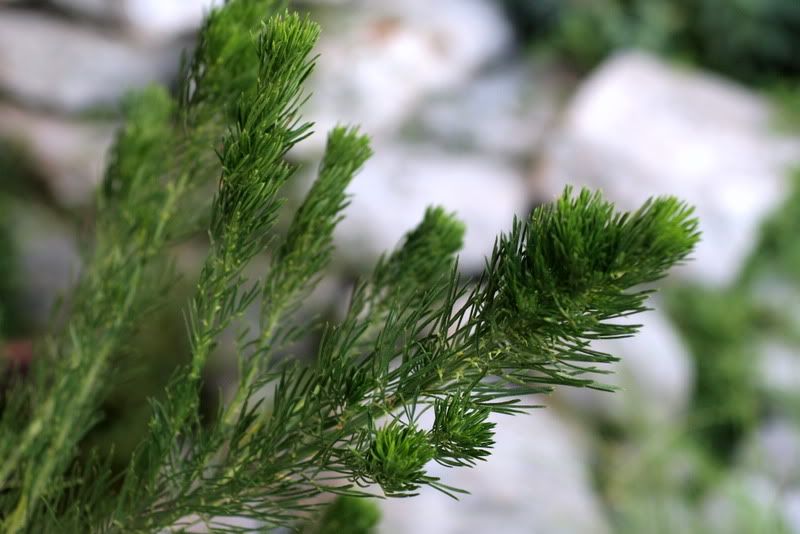
“What’s this one?” he fired back at me.
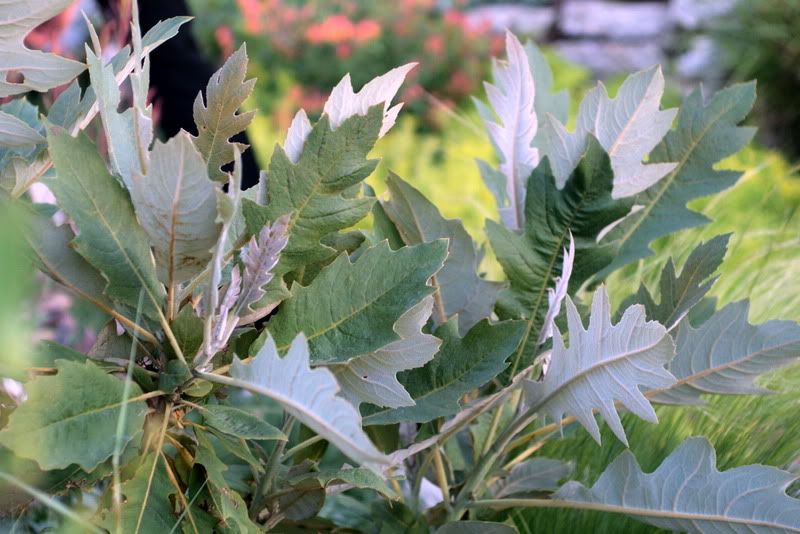
My wobbly response: “Um, a loquat maybe?”
“Bocconia.”
“Oh, right, the macleaya relative! I saw it at the Huntington years ago.” (What a piece of work is a brain.)
An especially fine form of Echeveria agavoides is scattered by the dozens throughout the garden, chunky as an artichoke agave/A. parryi var. truncata. “Chinese Dunce Cap,” Orostachys iwarenge, is the silvery succulent lower right among the sedum.
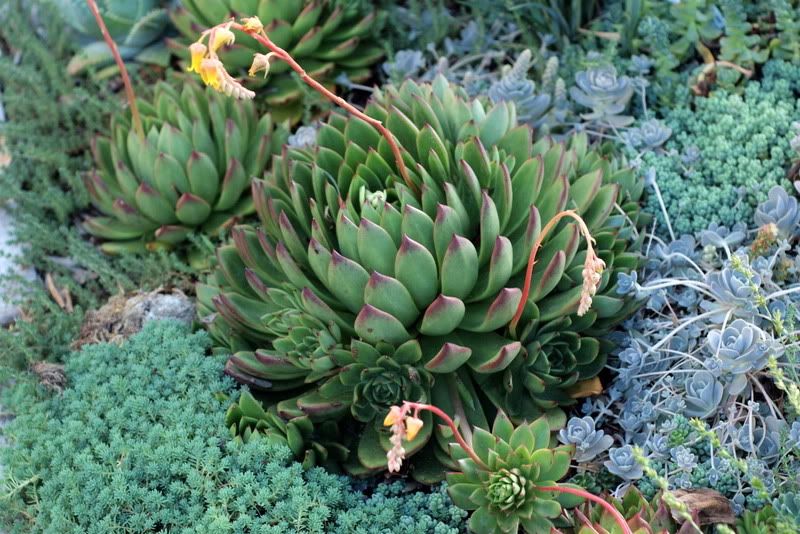
Detail of the rebar arbor and new growth on the weeping…um, conifer. Not the Kashmir cypress. (Memory, speak!)
(4/27/11 Dustin speaks: Cedrus deodara ‘Feelin” Blue’)
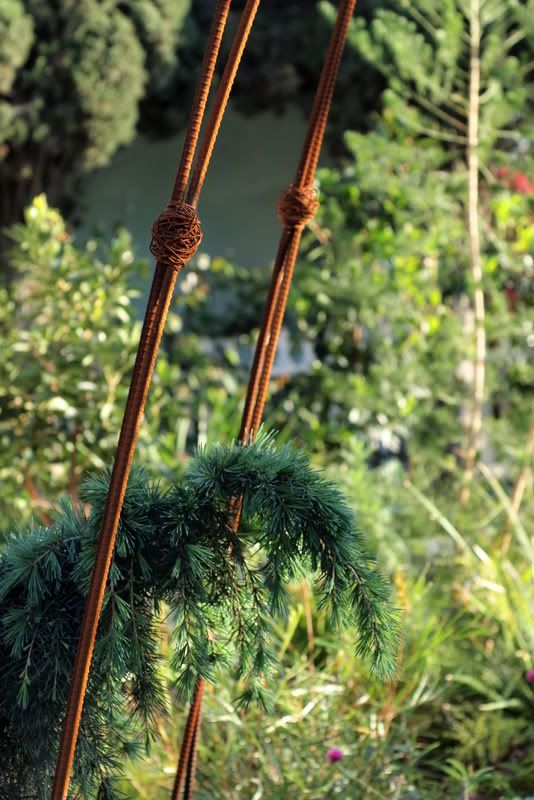
Gunnera in a gigantic ceramic container, at least 5 feet high, a pot that he picked up for a song.

Plants seem to follow Dustin home like puppies. They so desperately want to live in his astounding garden.
“What’s this one?” he quizzed me excitedly, as we stood before his latest acquisition, still in a nursery gallon.
Shifting my weight, a physical manifestation of being caught off balance, another wobbly response: “Well, a conifer, of course.” Strictly buying time. I really hadn’t a clue.
Recognizing that I had no botanical chops for this game, he abandoned the quiz and announced triumphant, “It’s the Kashmir cypress!”
Cupressus cashmeriana, a lovely thing, and aptly named for its textural qualities as well as geographic provenance, with leaves like fringe on the finest pashmina shawl. Yesterday, absent-mindedly picking up my “Power of Gardens,” by Nancy Goslee Power, I started reading about her little garden in Santa Monica and was immediately struck by this photo:
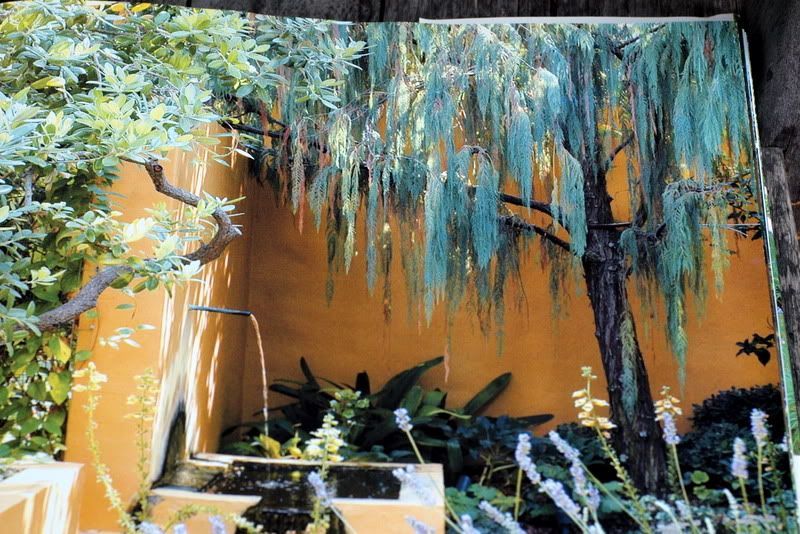
How many times have I scanned this book and flipped by this page without really seeing the full-page photo of this tree? It was only because I was actually reading the text this time, Ms. Power’s narrative of the making of “Casa Nancina,” that I noticed the mention of this conifer and then linked it to the photo opposite. And it was only because I had seen this tree the night before that the photo then made me gasp in recognition. The quiz tree!
Ms. Power writes: “A feathery and rare Kashmir cypress casts a soft shadow on the fountain and courtyard, blocking the intense western sun and my neighbors’ large house. The cypress is one of a group that I had grown for the Norton Simon garden and is very dear to my heart.”
From San Marcos Growers: “This beautiful evergreen conifer from south Tibet grows to 40 to 60 feet tall. It has a narrowly pyramidal shape with upright main branches and long (often several feet) pendulous branchlets bearing blue-green, aromatic foliage. This is a beautiful species, but it can also be a little fussy. It can easily be damaged in winds and may die in prolonged dry, hot weather. It is hardy to about 15-20° F…The largest tree in the United States was a beautiful 60 foot tall specimen in the lawn adjacent to the succulent garden at the Huntington Botanic Gardens in San Marino, California. This tree was snapped off at the ground by winds during a storm in January 1997. This windstorm had microbursts measured in excess of 120 MPH by the nearby Jet Propulsion Laboratory (JPL).”
Again, how many times had I walked under the Huntington’s Kashmir cypress pre-1997, noting its beauty then instantly forgetting the experience? (Especially if I stepped into a jaw-dropping succulent garden just afterwards.) I bet we all do this hundreds of times a day — noting something wondrous but retaining no lasting memory of it, the short-term,”tear sheet” memories getting bumped and emptied out of the neural recycle bin countless times a day. My middle-aged brain needs an extra kick in the pants to retain information, a serendipitous echo or re-encounter, or better yet, a story, which the book text and photo provided. (Another reason to check out the Norton Simon in Pasadena now, to see how their Kashmir cypresses are faring, combined with a quick trip to the Huntington to see the puyas in bloom.)
I’ll be ready for the quiz next time.

It’s funny how even for devout gardeners, some amazing plants just stay in the background of our awareness until we get to know them, then they seem to show up spontaneously in gardens around town and on the pages of books and magazines.
Thanks for the photos of Dustin’s garden. I really love his plants, and his projects, but he doesn’t spoil us with prolific blog posts like you do.
Ryan, that’s exactly what I was trying to express. And to borrow Reuben’s phrase, I do tend to “overshare.” Dustin could run five daily blogs on what goes on in his garden!
I second what Ryan said, so true!
It’s wonderful to see your photos after having looked at Reuben’s and Dustin’s. You all have such a different eye on the same plants and garden. I especially appreciated your close up of the “mystery” succulent!
I love the way you tell stories about gardens. Speaking of Kashmir cypress, this incredible tree is growing in Austin in designer James David’s garden, which one can visit on the Open Days tour every other year. It’s a stunning specimen, and I have to stand and stare at it every time I see it. I can’t quite believe he is able to keep it alive here, as we definitely have prolonged hot, dry weather, high winds, and occasional freezes in the danger zone. I guess he’s just working his magic, that’s all.
Loree, I was trying to be discreet and not drop too many names!
Pam, I love James David’s garden, which I think I found thru your blog. Some people just have that magic with plants.
The succulent shot is amazing!!! Orostachys iwarenge has to be one of the cutest succulents on the planet. What a fabulous garden!
The cedar you seek on the rebarbor is called ‘Feelin’ Blue’. Thanks for the lovely post. You can quiz me next time I get to see your garden.